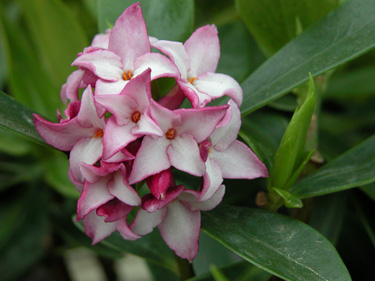Grow daphne
A single sprig of daphne can fill a room with perfume. Such powerful fragrance on a small evergreen shrub is especially precious in mid winter!
Some time around July is flowering time for the traditional favourite pink and white odora daphnes, Daphne odora ‘Leucantha’, Daphne odora ‘Leucantha Alba’and Daphne odora ‘Leucantha Rubra’. These are the most widely grown daphnes. Even when not flowering they are attractive compact shrubs, with glossy green evergreen foliage.
But they’re not the only daphnes worth planting. Altogether there are over 50 naturally occurring species and a number of garden cultivars.
Daphne bholua (Himalayan daphne) is a tall (2m) narrow slightly scruffy shrub with dull deep green leaves. Clusters of very sweetly fragrant white-pink flowers are its feature through the winter. Plant it near the back of a border where its unsightly habit is hidden but the wonderful fragrance can be enjoyed.
Released in 2016, Daphne Perfume Princess is a cross between Daphne odora and Daphne bholua, bred here in NZ by Mark Jury. It was awarded Plant of the Year at the 2016 Australian Nursery and Garden Industry Association’s National Conference. This is the earliest and longest flowering of all daphnes, with one of the sweetest fragrances, and is prized for its profusion of large blush pink (softly fading to white) sweet perfumed flowers. It offers a progression of large blooms along the stem making it perfect for cutting to bring indoors. It is an excellent garden plant with upright and slightly spreading attractive evergreen foliage. Daphne Perfume Princess flowers from winter to late spring and is perfect for containers and in the garden.
How to grow daphne
- Plant in cool lime-free soil, enriched with plenty of organic matter.
- Well-drained soil is critical. Daphnes hate wet feet. Established are more likely to live a long life in relatively dry conditions than in soil that lies wet in winter.
- Nutrient imbalances caused by high pH and/or poor drainage result in yellow leaves. As with camellias and Rhododendrons, daphnes prefer a near neutral soil.
- Iron deficiency usually appears first on new growth as small leaves or yellowing between veins. If your soil is well-drained soil but yellow leaves persist, try a dose of iron chelates to correct a possible iron deficiency.
- Part shade is best for most daphne varieties. All day direct sun can turn leaves yellow. On the other hand, too much shade will limit their flowering.
- Maintain a layer of organic mulch such as leaf mould or fine bark. Top it up each year, but don’t pile it up around the stems.
- Trimming lightly after flowering, or simply picking the flowers, helps to keep growth compact. Do not prune right back below the foliage.
- When a daphne bush suddenly gets sick and dies, the most likely cause is root rot arising from poor drainage. If your healthy daphne is getting on in years, you might want to get another one growing, just in case. Seven years is considered a good age, although they can live much longer.
- It’s also worth noting that Daphne odora is a far more reliable plant today than it has been in the past. Towards the end of last century many cutting grown plants had become infected with virus. Fortunately tissue culture has come to our rescue and good nurseries are careful to grow daphnes only from virus free material.
11-Jul-2014

Daphne odora 'Leucanthe'

Daphne Perfume Princess - photo courtesy of Abbie Jury www.jury.co.nz

Daphne odora 'Leucanthe Alba'

Daphne odora 'Leucanthe Rubra'

Daphne bholua


